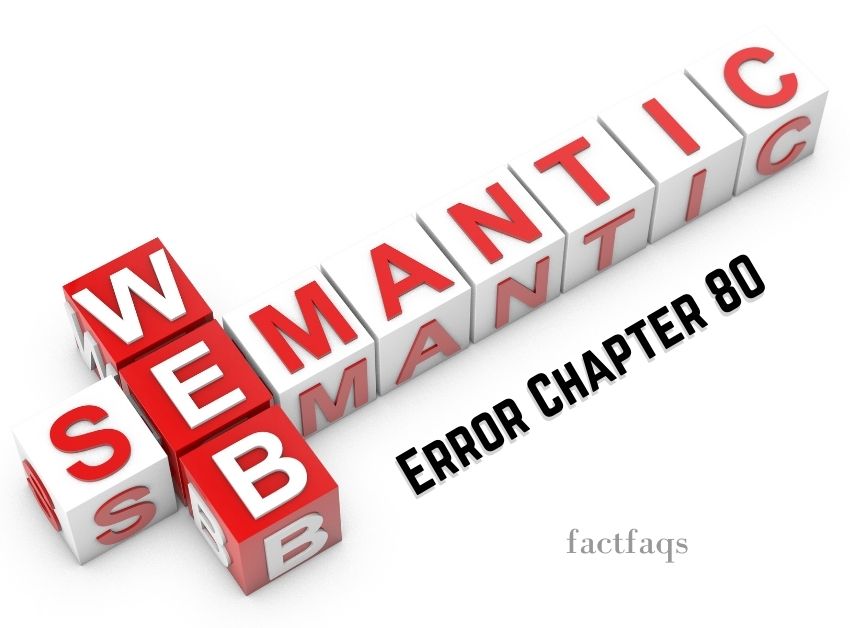In Semantic Error Chapter 80, Sangwoo’s attempt with another boy leaves him unsatisfied. He pushes the blond boy, but the situation takes a different turn when the boy forces Sangwoo to proceed.
This chapter explores the complexities of Sangwoo’s experiences and their impact on his journey. Semantic Error is a popular webcomic/manhwa that has gained attention for its unique storytelling and captivating plotline. It serves as the source material for the hit K-drama and offers the legitimate version of the story, updated regularly and exclusively.
Chapter 80 delves into the nuanced dynamics between the characters, weaving an engaging narrative that keeps readers hooked. Join us as we explore the intricate world of Semantic Error and discover the outcomes of these intense moments.
What Is A Semantic Error In Programming?
Explanation of semantic error concept: A semantic error is a type of programming error that occurs when the code is syntactically correct, but it produces unintended or incorrect behavior. Unlike syntax errors, which are detected by the compiler or interpreter, semantic errors are more challenging to identify as they do not result in immediate error messages. These errors can lead to logical inconsistencies, unexpected output, or program crashes.
Importance of identifying and fixing semantic errors in programming: Recognizing and resolving semantic errors is crucial in developing reliable and functional software. Failing to address these errors can result in applications that do not behave as intended, leading to user dissatisfaction, security vulnerabilities, or financial loss. Therefore, developers should conduct thorough testing and debugging to identify and correct any semantic errors present in their code.
Impact of semantic errors on program execution and functionality: Semantic errors can have significant consequences on the execution and functionality of a program. They can lead to incorrect calculations, data corruption, and unexpected program behavior. Additionally, semantic errors can be challenging to trace and debug, as they often involve logical mistakes or incorrect assumptions. Therefore, programmers must carefully analyze and debug their code to ensure the absence of semantic errors before deploying their software.

Understanding Semantic Error Chapter 80
The overview of Semantic Error Chapter 80 provides insights into its purpose and scope in programming. This chapter delves into the concept of semantic errors and their significance in the programming world.
Semantic errors occur when the code is grammatically correct but fails to produce the expected outcome due to logical mistakes. They can be challenging to detect and rectify as they do not result in immediate error messages.
This chapter aims to enhance the understanding of programmers regarding common semantic errors and strategies to identify and resolve them. By exploring various examples and scenarios, readers can gain valuable insights into debugging techniques and best practices to improve code efficiency and functionality.
Additionally, this chapter may discuss tools and technologies that assist in identifying semantic errors, common pitfalls to avoid, and suggestions for best coding practices.
Common Types Of Semantic Errors
Semantic Error Chapter 80 delves into the common types of semantic errors that can occur in programming. These errors can lead to incorrect interpretation of code and affect the functionality of a program. Understanding and identifying these semantic errors is crucial for efficient coding.
Read the chapter to gain insights into this important aspect of programming.
| Common Types of Semantic Errors |
|---|
| Variables and data types: Semantic errors related to variables and data types occur when incorrect or incompatible data is assigned to variables or used in operations. These errors can result in unexpected program behavior or runtime errors.
Conditional statements and loops: Semantic errors in conditional statements and loops can occur when the logic of the statements or loops is incorrect or when the conditions are not properly evaluated. Function usage and execution: Semantic errors can arise when functions are used incorrectly, such as passing incorrect arguments or not following the proper syntax and conventions of the programming language. Memory management and allocation: Semantic errors related to memory management and allocation occur when memory is not properly allocated or released, leading to issues like memory leaks or accessing deallocated memory. |
Examples Of Semantic Errors In Chapter 80
One common type of semantic error in programming is when incorrect variable declaration and usage occur. This happens when a variable is declared with the wrong data type or is used in a way that is not compatible with its intended purpose. For example, if a variable is declared as an integer but is later assigned a string value, this would result in a semantic error. Developers should carefully review their code to ensure that variables are declared and used correctly.
Another example of a semantic error in Chapter 80 is incompatible data type assignments. This occurs when data of one type is assigned to a variable that can only accept a different type of data. For instance, trying to assign a character value to an integer variable would result in a semantic error. It is important for programmers to be aware of the data types they are working with and ensure that data is assigned correctly.
Semantic errors can also arise from logic and control flow mistakes. These errors occur when the program does not follow the intended logic or control flow, resulting in incorrect outcomes or unexpected behaviors. Examples of logic and control flow mistakes include missing or misplaced conditional statements, incorrect loop conditions, or improperly nested statements. Developers should carefully design the program’s logic and control flow to avoid these errors.
Another type of semantic error in Chapter 80 is memory leakage and segmentation faults. Memory leakage occurs when a program fails to deallocate memory that is no longer needed, leading to wasted resources and potential crashes. Segmentation faults occur when a program accesses memory that it does not have permission to access. Both memory leakage and segmentation faults can result in program instability and unexpected behaviors. Developers should be mindful of memory management and ensure proper allocation and deallocation of memory.
Challenges In Debugging Semantic Errors
Debugging semantic errors can be a challenging task, requiring keen attention to detail and a deep understanding of the code. With Chapter 80 of Semantic Error, developers face the complexity of diagnosing and resolving these elusive bugs, ensuring the smooth functionality of their programs.
Identifying And Isolating Semantic Errors
Debugging semantic errors can be a daunting task, as they are often elusive and difficult to pinpoint. However, by following effective debugging techniques and utilizing the right tools, developers can overcome these challenges.
One of the key steps in identifying semantic errors is to thoroughly understand the code and its intended functionality. By carefully analyzing the code, developers can look for inconsistencies or logical flaws that may lead to semantic errors.
Isolating semantic errors requires a systematic approach. Developers can start by dividing the code into smaller sections and testing each section individually. This allows them to narrow down the potential sources of errors and focus on specific areas of the code.
Another useful technique is to carefully interpret error messages. Error messages provide valuable information about the nature of the error and its potential causes. By understanding the error messages, developers can effectively troubleshoot and fix semantic errors.
Finally, utilizing debugging tools can greatly aid in the process of identifying and fixing semantic errors. These tools provide functionalities such as stepping through the code, inspecting variables, and tracking the flow of execution. By leveraging these tools, developers can gain additional insights and speed up the debugging process.

Best Practices To Avoid Semantic Errors
When it comes to avoiding semantic errors, one of the most effective strategies is code review and peer programming. It involves reviewing each other’s code and working together on the same piece of code. This practice helps to identify errors and fix them before they become bigger issues. It also promotes collaboration and knowledge sharing among team members. To ensure the effectiveness of code review and peer programming, it is important to establish clear guidelines and standards for reviewing code. This can include checking for correct use of variables and functions, proper naming conventions, and adherence to coding best practices.
Unit testing and test-driven development are essential practices in software development that can help prevent semantic errors. Unit testing involves writing small, automated tests for individual units of code to ensure they function as intended. Test-driven development takes this a step further by requiring tests to be written before the actual code. This helps to identify and fix any potential semantic errors early on in the development process. By thoroughly testing the code, developers can have more confidence in its correctness and reliability.
Another valuable practice to avoid semantic errors is using consistent coding conventions and styles throughout the project. This includes maintaining a consistent indentation style, naming conventions, and commenting style. Consistency not only makes the code more readable but also ensures that everyone on the team understands and follows the same coding standards. Additionally, using automated tools and linters can help enforce these coding conventions and catch any potential semantic errors that may arise due to non-compliance.
Also Read More:
A Story About Sitting Next to a Scary Yakuza:
Impact Of Semantic Errors On Program Performance
Semantic errors in programming can have various impacts on program performance. These errors arise when there is a mismatch between the intended meaning and the actual execution of the code. Understanding the effects of semantic errors is crucial for developers to optimize their programs and deliver high-quality software.
| Efficiency and Performance Issues | Security Vulnerabilities and Risks | User Experience and Customer Satisfaction |
|---|---|---|
| Semantic errors can adversely affect the efficiency and performance of a program. These errors can cause the program to run slower or consume excessive resources, leading to degraded performance. | Another concern with semantic errors is the potential security vulnerabilities they introduce. These errors can be exploited by hackers to gain unauthorized access, manipulate data, or cause system failures. | Semantic errors impact the user experience and customer satisfaction. Bugs resulting from these errors can lead to crashes, unexpected behavior, or incorrect outputs, frustrating users and damaging the reputation of the software. |
To ensure the smooth functioning of a program, it is crucial to identify and fix semantic errors during the development lifecycle. Rigorous testing, code reviews, and following best practices can help minimize the occurrence of these errors and ultimately enhance program performance and reliability.
How To Fix Semantic Errors In Chapter 80
Semantic errors can be frustrating, but there are steps you can take to fix them in Chapter 80. The first step is to analyze the error messages and logs. Look for any specific details that can help pinpoint the issue. Debugging and step-by-step execution is another effective technique. Go through the code line by line, checking for any inconsistencies or mistakes. Applying systematic troubleshooting techniques is also crucial. This can involve breaking down the problem into smaller parts and testing each component individually. By following these steps, you can resolve semantic errors and ensure smooth functioning of Chapter 80.
Frequently Asked Questions On Semantic Error Chapter 80
What Is Semantic Error Chapter 80 About?
Semantic Error Chapter 80 continues the captivating story of the webcomic. Discover the new twists and turns as the characters navigate through challenges and unexpected events.
Who Are The Main Characters In Semantic Error Chapter 80?
In Semantic Error Chapter 80, the main characters include [insert names of the main characters]. Follow their journey as they face thrilling adventures and develop their relationships.
Where Can I Read Semantic Error Chapter 80 Online?
You can read Semantic Error Chapter 80 online on the official webcomic platform, Manta. Enjoy the latest updates and dive into the immersive world of Semantic Error.
How Often Are New Chapters Released For Semantic Error?
New chapters of Semantic Error are typically released on a regular basis. Make sure to stay updated by following the official channels to catch the latest exciting episodes.
Conclusion
In this chapter of “Semantic Error,” the plot takes an unexpected turn as Sangwoo’s encounter with another boy doesn’t bring him the satisfaction he hoped for. However, the situation quickly escalates when the blond boy refuses to back down, forcing Sangwoo into a difficult position.
As the story unfolds, the webcomic continues to captivate readers with its unique twists and turns. For those who can’t get enough, Manta offers the legitimate version of “Semantic Error,” ensuring readers can stay up-to-date with the fastest updates. Dive into the world of this hit K-drama and indulge in the never-ending story of teasing and flirting between Seoham and Jaechan.
Tune in for the intriguing continuation of “Semantic Error. “
